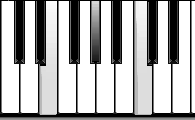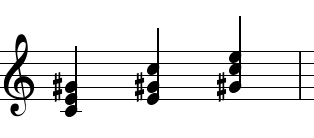Answer: This sounds like a riddle, or maybe a Zen koan. It's sort of a trick question - there isn't a triad that looks the same regardless of inversion. But there is a triad that on the piano looks the same as two others in different inversions.
The augmented triad consists of two major thirds, and when played on the piano it's impossible to tell from just looking at the keys if the chord is in root position, first inversion, or second inversion, because you don't know which note is the root unless you know how the pitches are named - i.e. how they would look when notated. The following could be E augmented, or the same keys could represent the first inversion of C augmented, or the second inversion of Ab augmented:

So maybe that's what the interrogator has in mind. But when seen in notation it's easy to tell what's up - here are three inversions of C augmented:

E augmented would use a B# instead of C, and Ab augmented would use an Ab instead of G#. When notated there is no ambiguity.
A similar case is the diminished seventh chord, though it's not strictly speaking a triad, having four pitch classes. If you see that chord played on a piano it is impossible to tell whether the chord is in root position, first, second, or third inversion. The root is ambiguous - it could be any of those four pitches, depending on how they are named.

